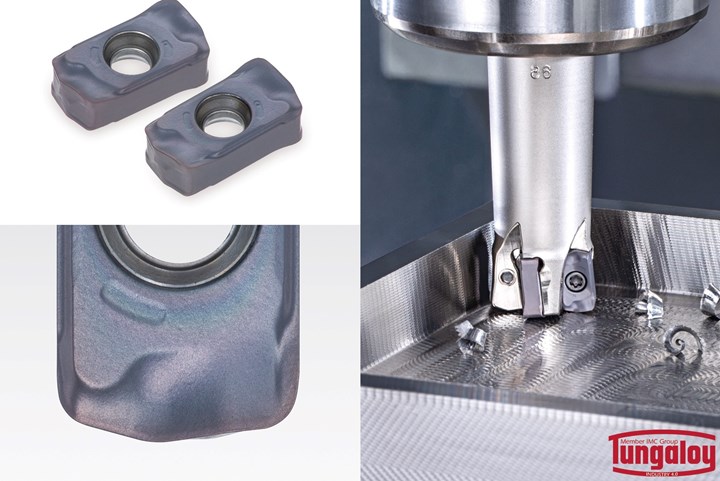Inserts Improve High-Feed Milling Performance in Exotic Materials
The Tungaloy DoFeed high-feed milling cutter series now offers new LNMU0303UER inserts available in Size 03 for a smaller approach angle, effectively cutting loads, minimizing damage and ultimately improving tool life.

Photo Credit: Tungaloy America
Tungaloy America has expanded its DoFeed high-feed milling cutter series by adding six LNMU0303UER inserts. DoFeed, a high-feed milling cutter series, features economical double-sided inserts with four cutting edges, offering a wide variety of cutter body diameters and styles.
New LNMU0303UER inserts are available in Size 03 and designed to provide long tool life, the company says. These UER inserts are interchangeable with existing ZER inserts on the same cutter body.
The LNMU0303UER inserts are designed to provide a smaller approach angle than existing LNMU0303ZER inserts when set on the cutter body so that the insert generates thin chips. This chip thinning effect reduces cutting loads, minimizing damage on the cutting edges during machining of exotic materials for longer insert tool life. Also, a small approach angle directs the cutting forces in the axial direction towards the spindle. This amounts to less tool deflection, as there is much less radial force pushing the cutter off its center axis, enabling stable long overhang machining without compromising cutting parameters.
Two chipbreaker styles are available: MJ is suited for general purpose applications and ML boasts sharp cutting edge and low cutting forces. Inserts are offered in AH3225 grade for steel, fracture-resistant AH130 grade for stainless steel and titanium alloys and AH8015 for machining hardened steel and cast iron.
DoFeed series is said to offer an extensive lineup of inserts and cutter bodies ranging from 16-50 mm (from 0.630-2″) diameters to provide high productivity for a wide range of applications.
Related Content
-
Treatment and Disposal of Used Metalworking Fluids
With greater emphasis on fluid longevity and fluid recycling, it is important to remember that water-based metalworking fluids are “consumable” and have a finite life.
-
The Benefits of Hand Scraping
Accuracy and flatness are two benefits of hand scraping that help improve machine loop stiffness, workpiece surface finish and component geometry.
-
Advantages and Disadvantages of Copper and Graphite Electrodes
Both copper and graphite provide approximately the same end result, so it is important for a shop to consider the advantages and disadvantages of each material in order to discover what would work best in their shop floor environment.
.png;maxWidth=970;quality=90)






.png;maxWidth=300;quality=90)







